George Hodel: Doctor. Genius. Serial Killer? How One Man Has Become the Main Suspect in the Black Dahlia Slaying.
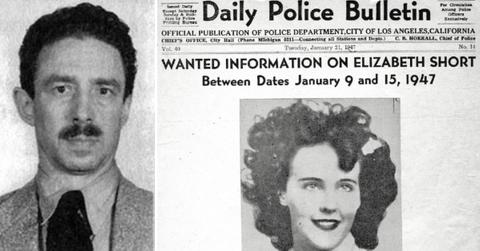
March 4 2024, Published 12:02 p.m. ET
This year marked the 74th anniversary of the killing of Elizabeth Short, better known as the Black Dahlia. Possibly the biggest criminal sensation in the history of Tinseltown, the gruesome murder exposed the dark underbelly of 1940s Hollywood to a public eager to hear more.
From accusations of vice rings and underground abortion clinics, the Dahlia case has turned stomachs for its glimpse into the debauched world of celebrity as much as the famous images of Short's dismembered body.
Over the decades, endless names have been suggested as the Black Dahlia killer. From the absurdity of an accusation against Orson Welles to the very possible Leslie Dillon or Walter Bayley, dozens of suspects have been analyzed at length. However, one name might be said to have become firmly etched in the public's mind as the killer — George Hodel.
Thanks to books from Hodel's own children and a successful adaptation of one of them as the TNT mini-series “I Am the Night” starring Chris Pine, Hodel has been accepted by many as the leading suspect in the Dahlia murder. Steve Hodel, George's son, even claims his father was the Zodiac Killer.
But just who was George Hodel, and does he truly deserve his place as one of the leading suspects in the killing that mystified America for over seven decades?
GROWING UP
George Hill Hodel Jr. was born on Oct. 10, 1907, in Los Angeles. Of Russian-Jewish ancestry, Hodel was a child prodigy and possessed a clear genius-level intellect. Such was his mind that he reportedly scored 186 on an IQ test, one point higher than Albert Einstein. Great things were expected of George, yet his first love was music.
A polymath, Hodel excelled in most fields he put his mind to, the piano was no different. His talent led to the legendary Sergei Rachmaninoff traveling to the Hodel house to just hear the young man play. George graduated high school by the age of 15 and attended The California Institute of Technology, yet his dreams would soon come tumbling down.
During his time at Cal Tech, Hodel became sexually involved with the wife of one of his professors. This alone would have been a bad enough scandal for the young man yet making the matter all the more outrageous to the university was the woman in question was now pregnant.
Likely consumed with teenage lust and fantasies of doing the chivalrous thing, Hodel urged the woman to leave her husband and join him in raising the child together. She refused, and not only did the woman's marriage fall apart, but Hodel was forced to leave the university.
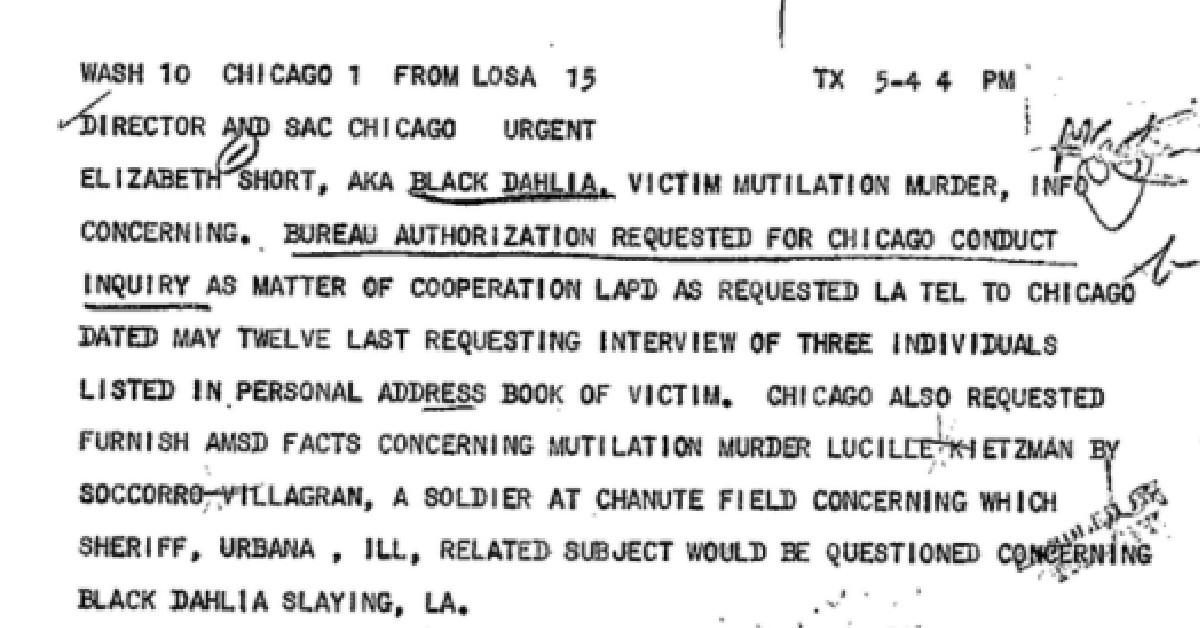
A Memo in the FBI's Elizabeth Smart file
Hodel's education would fall by the wayside for several years. During the 1920s and 30s, he was married twice, having children by both women, one of whom would become instrumental in future proceedings against him, Tamar Hodel. Taking up photography and starting his own literary magazine, it wouldn't be until June of 1932 that Hodel graduated from the University of California-Berkeley pre-med, following it with a medical degree from the University of California in 1936. He immediately set about making up for lost time, and in a few short years, his medical practice was one of the most noted in the state. Hodel was appointed to lead the county's Social Hygiene Bureau and moved to Los Angeles.
Finally, his career was back on track.
A TWISTED LIFE
Hodel was fascinated with art and particularly by surrealism, the movement that developed toward the end of World War I. The genre frequently utilized irrational themes of differing realities, bringing forward feelings that might be considered erotic, unsettling, illogical and even violent. Centered on the unconscious, Hodel enjoyed the darker aspects of the movement alongside the general decadence of the Hollywood art scene in general.
He was interested in the debauchery of the Marquis de Sade, the historic rapist, pedophile and torturer of women who, despite his crimes, has held a fascination in liberal and libertine circles for generations. Sex, drugs and alcohol were the norm.
"It's an evil place. Women were tortured for sport there. Murders happened there." — Art photographer Edmund Teske on the Hodel household
Already friends with the film director John Huston from his teenage years, Hodel made new friends during this period in his life, and he met the photographer Man Ray whose work he admired, though they weren't friends, as some accounts claim. Hodel was eagerly welcomed into these circles, and in 1940 he married Huston’s ex-wife, Dorothy Harvey. They had three children together.
However, this is far from to say that Hodel had settled down; in fact, quite the opposite was true. Not only did Harvey live at Hodel's striking mansion in the Los Feliz section of Los Angeles, but at varying times so did his ex-wife Dorothy Anthony and their daughter Tamar.
At other times, his first wife, Emilia, lived at the property. Beyond his three wives, Hodel regularly engaged in affairs across Los Angeles, few women lasting longer than a short period before being cast aside. In 1949, witnesses stated one of these women was Short, the Black Dahlia.
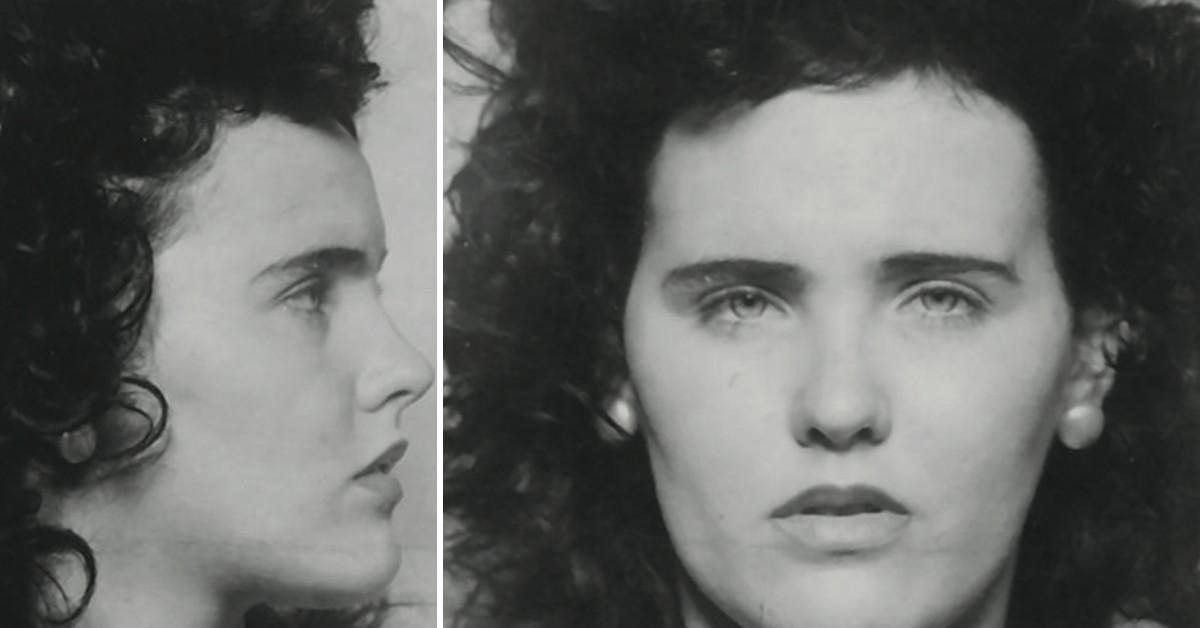
Elizabeth Short
The body of Short was found on Jan. 15, 1947, naked, mutilated and bisected at the waist. Her mouth had been cut from ear-to-ear, commonly now known as the "Glasgow smile" due to its origins in Scotland. The case was one of the most sensational of the 20th century, with the press blanketing newspapers with sordid details of Tinseltown vice.
The killing would go unsolved, yet there was no shortage of suspects. One of them was Hodel.
TIES TO OTHER INCIDENTS
In 1945, Hodel's secretary, Ruth Spaulding, died from a drug overdose. Hodel was there when she died and had burned papers belonging to her before he called the police. He was never charged with anything, yet documents have shown that Spaulding knew much of Hodel's darker side.
It is believed by some she was aware he engaged in a financial fraud whereby he billed patients for medical procedures and tests that he never actually carried out. There have also been rumors that he worked as an illegal abortionist and performed abortions for both Hollywood's social elite and prostitutes impregnated by Los Angeles police officers.
Spaulding was ready to blow the whistle and had to go. With police getting dangerously close, Hodel had "fled" to China to work with United Nations’ relief efforts. However, the case was never a homicide investigation, and Hodel was never a suspect.
Equally, claims of doctors regularly performing illegal abortions are mostly legend. Those who had attained the level of success that Hodel had wouldn't even consider carrying out the procedure. Discovery would destroy their careers, and most abortions were carried out by students, nurses and those involved with medicine without actually being a medical doctor.
The law again surrounded Hodel in 1949 when his 14-year-old daughter Tamar accused him of incest and molestation. Alleging she got pregnant following a rape, Tamar claimed that her father had given her one of the back alley abortions some said he regularly performed on others. He forced her to perform oral sex on him. Man Ray had taken nude photos of her as a child. She had been pistol-whipped. Investigations into Tamar's allegations revealed she also accused her father of killing Short.
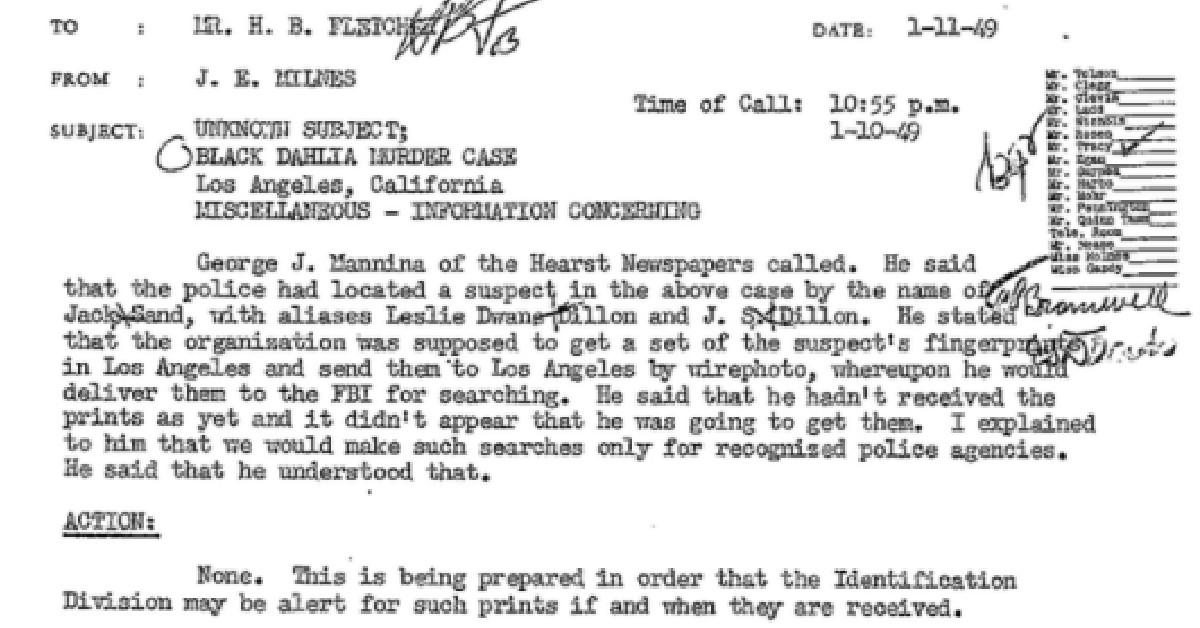
An FBI memo discusses a suspect in the Black Dahlia killing
What happened at the trial is a matter of perspective. Some say that despite two eyewitnesses stating they had seen George Hodel rape his daughter, his defense team led by celebrity lawyer Jerry Giesler successfully portrayed the teenage girl as mentally unstable. Money and influence won the day as a witness was paid off. It wasn't a fair trial.
On the other hand, Hodel piled most of his money into his defense and was nowhere near as wealthy or connected as many seem to believe. His daughter previously made an unfounded claim of rape against 19 high school students. Her mother and grandmother attested she was mentally ill and had a problem with compulsive lying and sexual disfunction. She had made other false accusations of molestation against others prior, including before living with her father. It was a fair trial.
In any case, Hodel was acquitted of all charges, but police were now particularly interested in the stories about him and the Black Dahlia.
TIES TO SHORT
Investigators discovered that no less than eight witnesses could put Short in Hodel's company, some even claiming they had engaged in a relationship. Conversely, even more denied the two knew each other.
Police also noted the medical background of their new suspect, believing that the Black Dahlia's bisection would have required anatomical knowledge. That said, Hodel was a medical doctor and not a surgeon, and whether he would have had the skill to bisect the body with the experience, care and attention is debatable.
Considering him a suspect, police bugged his Sowden House residence. What they would hear would seemingly confirm many of the rumors about his illicit activities. Hodel spoke of abortions and bribery to Los Angeles police officers, hinting he actually killed both Spaulding and Short.
"They thought there was something fishy. Anyway, now they may have figured it out. Killed her. Maybe I did kill my secretary." - Dr. George Hodel.
However, most of the transcripts from the house ultimately point away from Hodel as the killer, and many quotes are taken out of context. Knowing he was being bugged, the angry Hodel tried to antagonize the police he knew were listening, and many quotes are unclear.
By October, Hodel had been named before a grand jury as one of five suspects in the Dahlia killing. By April of the following year, Los Angeles police were apparently ready to arrest Hodel for the murder of Short. Some say he somehow got wind of the moves against him and fled first to Hawaii and then onto the Philippines three years later.
He would remain in the country until 1990, eventually dying in 1999. No charges were ever filed, and in the years that Hodel was in the Philippines, police are said to have privately believed the case was solved. However, if this was true and evidence was strong enough for an arrest, there had been no reason that Hodel couldn't have been extradited back to California.
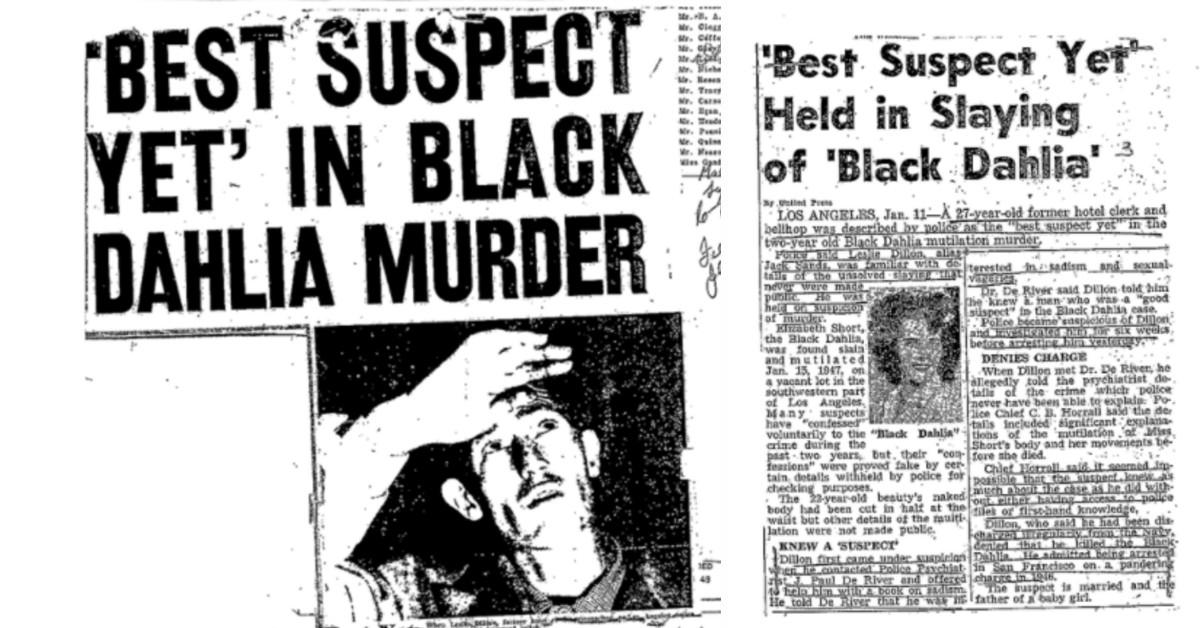
Newspaper clippings in the Elizabeth Short FBI file.
Equally, Hodel had been planning on leaving for some time, and he clearly states his intention to go to Asia on the transcripts from his house. The police were well aware of his intent and made no moves to stop him, Hodel feeling his reputation was in tatters after the molestation trial, despite being found not guilty.
Hodel's link to the Black Dahlia case was almost forgotten to criminal history until his son, Steve, began investigating his past after his father's death. A former Los Angeles police officer himself, Steve discovered photo albums he believes show the Black Dahlia, though others deny the women in the photos are Short, including her family.
Whether or not they are, Steve's investigations finally revealed his father's links to the crime, publishing the book “Black Dahlia Avenger” in 2003. Amongst the book's revelations were Steve Hodel's discovery of receipts showing his father purchased cement bags of the type found at the Dahlia crime scene and that both Hodel's wife and children were away from the house at the time of the killing.
Reactions to the book were mixed, with many concluding Steve built a convincing case against his father while others pointed out that there was no real evidence against him, even if he had known Short. Transcripts from the bugging of his house would never have been enough to convict, with much of the accusations being supposition and able to be put down as coincidence.
The evidence simply wasn't there, despite indications.
MEDIA TALES
While these indications certainly existed and those working on the case in the 1940s believed them credible, Steve brought his own conclusions into doubt with other wild theories surrounding his father's activities. “Most Evil” was published in 2009, “Black Dahlia Avenger II” in 2012, “Most Evil II” in 2015, and lately “Black Dahlia Avenger III” in 2018.
In many respects, these books weakened the case against Hodel by accusing him variously of being the Chicago Lipstick Killer, the Manila Jigsaw Killer and even the Zodiac Killer. Steve opened himself up to accusations of a vendetta and milking a money-making enterprise through additional books and media appearances
The 1946 Lipstick Murders involved the violent murder of two women and a child in Chicago, the killer leaving notes in lipstick at the crime scenes. William George Heirens confessed to the crimes, and while there may be some doubt as to his actual guilt, Hodel was never considered an alternative suspect until proposed by his son.
Steve’s theory suggests Short was investigating the killings in Chicago and got too close to the truth, creating a motive for her killing. The 6-year-old child killed during the Lipstick Murders, Suzanne Degnan, had been dismembered. Steve links this with the Dahlia, noting that the coroner stated that medical knowledge would have been needed to bisect the child.
Yet, it is little evidence for which to accuse a man of dismembering a child, and the police at the time favored a meat cutter. What the coroner actually said was: "either a man who worked in a profession that required the study of anatomy or one with a background in dissection… not even the average doctor could be as skillful, it had to be a meat cutter."
Similarly, Hodel's accusations that his father was the Zodiac Killer fail to live up to scrutiny. One of the few unsolved American crimes to rival the Dahlia case for notoriety, the Zodiac killings bare no similarity to the murder of Short.
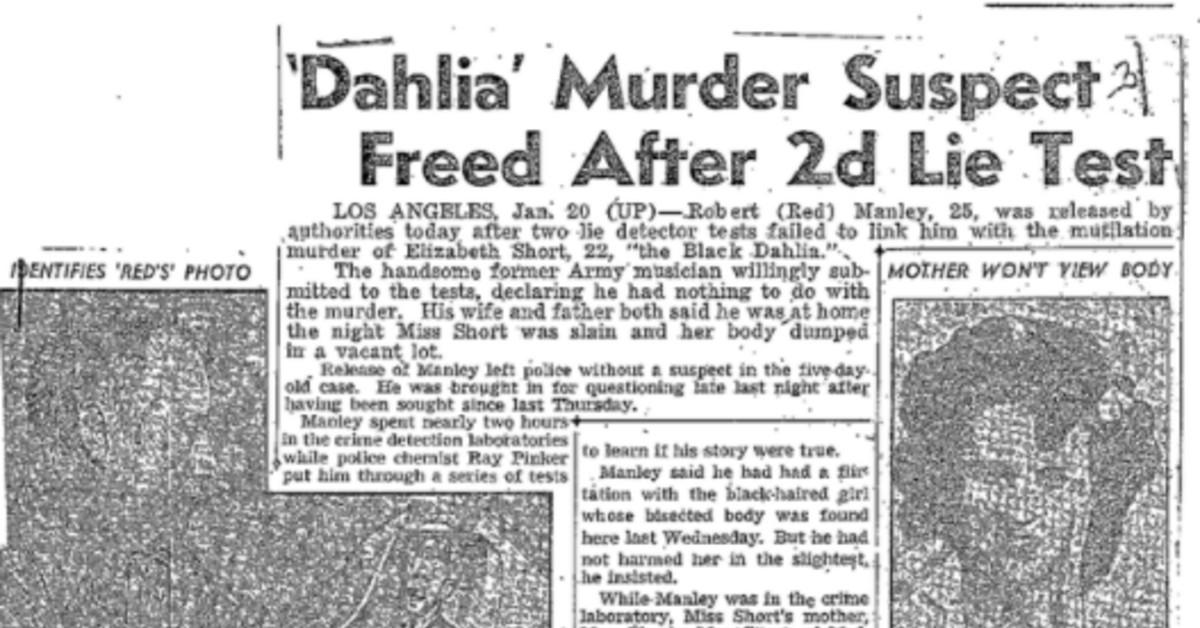
Newspapers gave heavy coverage in to the killing of Elizabeth Short
With five confirmed kills and possibly as many as 28 in total, the Zodiac targeted young couples and attacked them with a firearm or knife. Operating in Northern California, Hodel stretches his theory to suggest his father regularly returned from the Philippines to carry out the murders. Whilethe California Department of Justice could not be 100 percent certain the Zodiac's handwriting was not the same as George Hodel's, this is far from a confirmation of any link. Their failure to completely eliminate Hodel was merely a lack of samples rather than a belief that the accusation might hold water.
Similarly, claims in “Most Evil II” that the 1970 Zodiac cipher utilized an ancient medieval Irish alphabet and was signed "HODEL" are a stretch.
In 2013, a cadaver dog uncovered the faint smell of human remains at four points in the Sowden House's basement, the exact location that Steve alleged his father murdered and bisected Short.
Subsequent analysis of soil taken from the front and back of the house contained "numerous markers for a decompositional event" and that this event had been human-specific. Believing a burial site may be located just off the old Hodel property, requests for a search of adjacent grounds have been denied. While the results could be suggestive, it should be noted that the results of the decompositional event were dated anywhere between 20 and 100 years as of 2014, meaning the event could predate the house. Hodel only lived at the property between 1945 and 1950.
DID HE DO IT?
There are two George Hodels. There is the cunning and elitist criminal mastermind George Hodel, a dangerous and sadistic pervert who was seriously mentally unwell and enthralled by his own libertine pleasures. His attitude toward women was violent and possessive. They existed for his enjoyment, mere objects of artistic and carnal desire.
Conversely, Dr. George Hodel was committed to helping Los Angeles’ poor black population at his clinic and never hurt anyone. He was a man once considered a genius who was shamed by a false accusation, and his legend is built on yet more falsehood.
While on the surface, Hodel seems the perfect fit for the case, his candidature seems almost too perfect, and a more in-depth investigation reveals what is not being said about Hodel is far more critical than what is.
He is a Hollywood villain, often descending into the realm of a mustache-twirling cliche in a case that was built and destroyed off the back of sensationalism. He is an evil genius who befits his insertion into a subject as prominent as the Black Dahlia.
Much like the wild theories surrounding Jack the Ripper, freemasonry and royalty, these claims feed our desire for a story and turn a very real and brutal killing into a myth. They detach the reader from reality. No longer is the Black Dahlia a sordid tale of the sickening violence that "normal" and average men can deal out against women; now it is something fantastical.
It is disconnected from the real world. If Hodel is a "prime suspect," then that merely speaks of how little evidence there truly is against anyone in the affair. It is somewhat ironic that given the Los Angeles press' notorious role in the aftermath of the killing that Hodel's reputation is almost entirely built via the media.
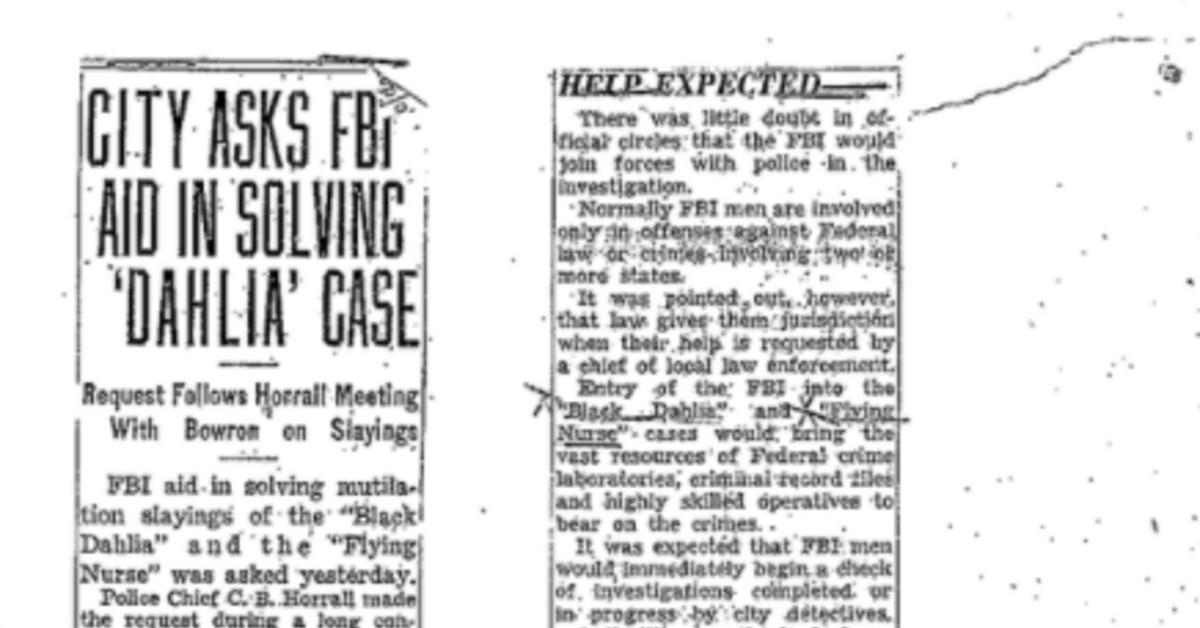
The FBI helped investigate, but hasn't solved, the Black Dahlia murder
Become a Front Page Detective
Sign up to receive breaking
Front Page Detectives
news and exclusive investigations.
